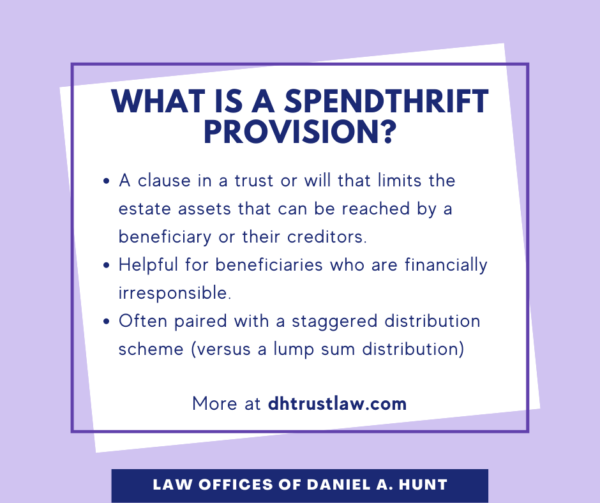What is a Spendthrift Provision?

If you want to leave an inheritance to a loved one who struggles to manage their finances wisely, a spendthrift provision may be a useful estate planning tool. A “spendthrift” is a person who spends money in an extravagant, irresponsible way. By adding a spendthrift provision to your estate plan, you can help ensure that you leave an inheritance to your loved ones, and not their creditors.
Understanding a Spendthrift Provision
First, what is a spendthrift provision? A spendthrift provision is a clause in a trust or will that limits the estate assets that can be reached by a beneficiary or their creditors. By including this provision in a trust, you can protect the beneficiary both from creditors and any debts they may otherwise seek to acquire based on their future inheritance.
A spendthrift provision states that any creditors of a beneficiary cannot attach (meaning gain a secured interest in) the trust assets as long as the assets remain in the trust. Once the beneficiary receives a payment from the trust, the creditor can seek repayment of the debt from that issued payment.
A spendthrift provision is often paired with a staggered distribution scheme that distributes the beneficiary’s inheritance in annual installments instead of a lump sum.
How a Spendthrift Provision Helps
Here’s an example of how a spendthrift provision might help you achieve your estate planning goals. Let’s say you have a son to whom you’d like to leave an inheritance someday. But you know that your son has made poor financial decisions in the past due to a gambling addiction. He doesn’t handle money well in general, and you worry that if he were to receive a large inheritance from your estate, he would quickly waste it.
Your estate planning attorney suggests that you include a spendthrift clause in your revocable living trust. This will prevent your son’s creditors from seeking payment for his debts directly from the trustee of your trust and from attaching an interest on his future distributions.
The provision also prohibits your son from assigning his future rights to payments from the trust. That means he can’t, for example, use his future inheritance to get credit to buy a luxury vehicle.
Finally, instead of leaving your son a lump sum distribution of your estate, you decide that your son will receive annual payments from the trust until he has received his full portion of your estate.
Drawbacks to a Spendthrift Provision
While a spendthrift provision and a staggered distribution can be useful tools, they’re not without drawbacks. If you opt to make annual distributions to a beneficiary, that means your trust will need to remain open and be managed by a trustee for an extended number of years.
This type of prolonged trust administration creates additional work and potential stress for your chosen trustee who will need to manage the trust and deal with the financially irresponsible beneficiary for a long time. Keep this factor in mind when choosing whether to use a spendthrift provision and when selecting your trustee.
Alternatives to Consider
If you’re looking for alternative estate planning options, some parents opt to disinherit spendthrift heirs. These parents have usually helped the spendthrift child financially in significant ways throughout their lifetime, perhaps more than other family members. To be fair, they may choose to disinherit that child and leave their estate to other relatives or to charity. If you’re considering disinheriting someone in your estate plan, be sure to consult with an estate planner about how to disinherit an heir properly to avoid future conflict and litigation.
An experienced estate planning attorney can help you draft an estate plan that accomplishes your goals for your legacy. If you have any questions about this topic, please feel free to contact our law firm.
Law Offices of Daniel A. Hunt
The Law Offices of Daniel A. Hunt is a California law firm specializing in Estate Planning; Trust Administration & Litigation; Probate; and Conservatorships. We've helped over 10,000 clients find peace of mind. We serve clients throughout the greater Sacramento region and the state of California.




